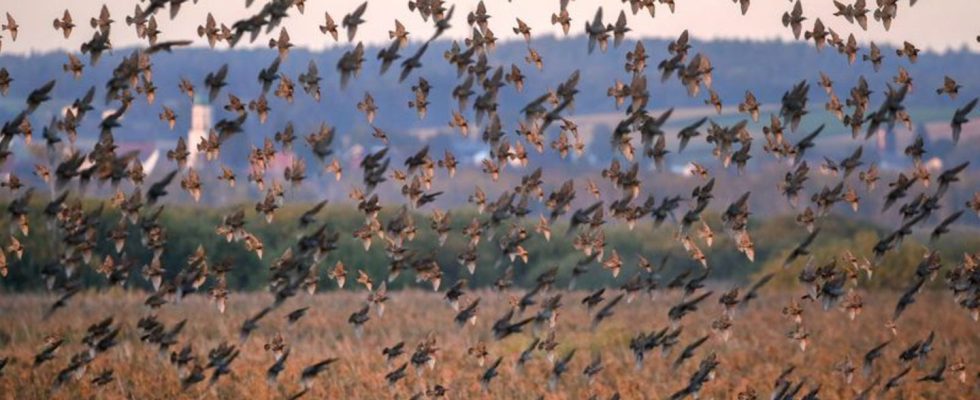Conservation Lobby
Birds, plants, presidents: Nabu is 125 years old
Hundreds of starlings over the Federsee nature reserve. photo
© Thomas Warnack/dpa
The members of the Nature Conservation Association look after individual animal species and work to combat the major crisis of species extinction. They once started fighting for certain species of birds.
The concerns have grown, as have the issues. Today it’s about the loss of species and the pollution of water and air, about urban sprawl and the consequences of intensive agriculture. But even 125 years ago, volunteers worked to protect living beings from the consequences of human actions – the Nature Conservation Association Germany (Nabu) was founded. One of the first campaigns was about women’s hats.
Who invented it?
For almost 40 years, the industrialist’s wife and mother of six Lina Hähnle (1851-1941) led the fortunes of the district, which was founded on February 1, 1899 in Stuttgart as the Association for Bird Protection (BfV). The “mother bird” knew how to assert herself in a society dominated by men. However, the role of their association in National Socialism remains controversial and has recently been examined. In 1966 the BfV became the German Federation for Bird Protection (DBV).
The circle of bird protectors, which initially had around 1,000 members, finally became Nabu decades later when the newly founded GDR Nature Conservation Association merged with the DBV in November 1990. With more than 900,000 members and supporters, it is now the environmental association with the largest number of members in Germany.
The purpose of the statutes has also changed significantly. While 125 years ago it was still about “working in a comprehensive way for the benefit of our useful birds”, today conservationists are committed to the bigger picture as well as to the small pond in the village.
What’s the point?
The bird protectors celebrated early successes, among other things, with the first managed protected area, the bird island near Giengen an der Brenz. One of the first successful campaigns to save great egrets and birds of paradise, whose magnificent feathers served as decoration for women’s hats, also became known. In 1914, bird conservationists imposed a ban on hunting in certain areas.
In addition to bird islands and nature conservation areas such as the reed areas at Federsee, Nabu operates nature conservation centers and offers excursions, projects and lectures. The “Bird of the Year” has been chosen together with the Bavarian State Association for Bird Protection (LBV) since 1971. Since then, the campaign has found a number of imitators, from trees to cave animals of the year.
Acting Nabu President Jörg-Andreas Krüger sees the founding of the Nabu Foundation for National Natural Heritage and the Nabu International Nature Conservation Foundation as one of the association’s greatest successes. While one buys valuable natural areas in Germany in order to permanently preserve them as a habitat for endangered animals and plants, the other is committed to nature conservation beyond Germany’s borders.
What is particularly problematic at the moment?
From Nabu’s point of view, nature conservation has not yet become a sufficient part of economic processes. “It is still relatively stuck in theoretical considerations and is not being rewarded on the market,” says Krüger. The protected areas, at least 17 percent of the country and inland waters, have not been adequately financed and protected.
However, most of the crisis issues – species loss, forest dieback, more droughts, storms and floods – can be found under the “umbrella problem of climate change”. “We already knew a lot of things at the end of the 1980s and warned. Now we see that this is exactly what is happening and we are under huge pressure to act,” said Krüger.
And what did a US president have to do with the matter?
At the beginning of the last century, the BfV pushed hard for bird protection. An advertising campaign in aristocratic circles succeeded in recruiting almost all the rulers of the empire for the alliance, at the top the kings of Württemberg and Saxony. This is followed by the monarchs from Sweden, Romania and Bulgaria. And in 1912 even US President Woodrow Wilson became a BfV member. In the same year, the USA imposed a ban on the import of wild bird feathers.

